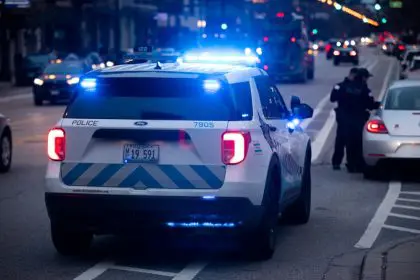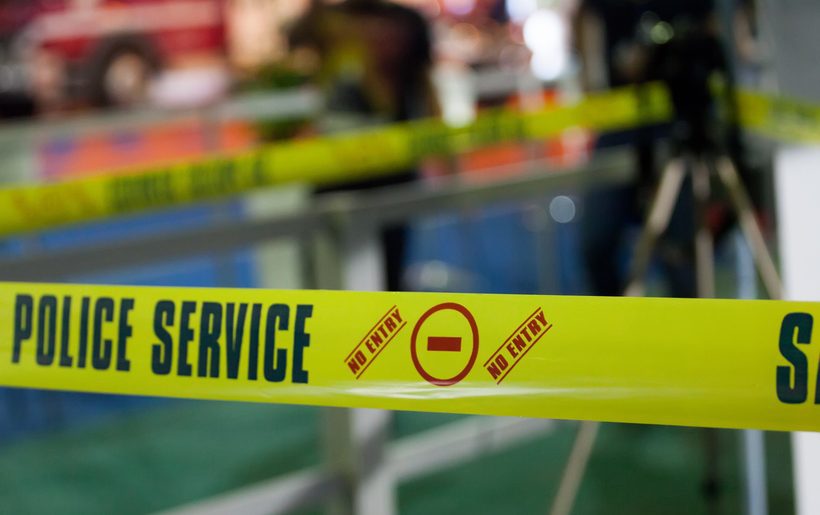
The smell of death was still in the apartment. Old blood and bits of brain matter splattered the walls and floors of the apartment of Jamarion Robinson. His family left it that way so others could see what US Marshalls did to the 26-year-old former Clark Atlanta University student. Robinson last attended CAU in 2009-2010, according to the university. On Aug. 5, 2016, in the metro Atlanta city of East Point, Georgia, police went to the Parkside at Camp Creek apartment complex on Washington Road to serve an arrest warrant. Robinson was accused of shooting at a police officer on July 28, 2016, in Atlanta. He was tracked to the apartment complex and US Marshalls from the Metro Atlanta Fugitive Task Force arrived to engage in what some are calling an extrajudicial execution.
Marshalls arrived at his door and announced their presence and with a few quick blows of a battering ram gained entry. Almost immediately gunfire from automatic weapons ripped through the apartment and into Robinson’s body. Round after round was fired for almost a minute, then there was a brief pause. Everyone thought it was over, even members of the East Point Police Department in the parking lot relaxed. Then suddenly the sound of an explosion echoed throughout the area as police deployed a flash-bang grenade inside the apartment. Again, there was a brief pause and seconds later once more gunfire as the US Marshalls continued their wild shooting. Finally, the ordeal was over and Robinson lay dead inside the apartment, executed by the police. Robinson’s body was riddled with more than 20 gunshot wounds and his hands were mangled from the police gunfire. When his grandmother, Beverly Nixon, arrived after the shooting, she was shown a picture of the suspect that police were looking for and she stated, “That’s not my grandson.”

For the next eight hours, his body lay inside his apartment as GBI investigators processed the shooting scene and gathered evidence. As family and friends gathered around the building Jamarion’s body was removed and sent to the Fulton County Medical Examiner’s office for an autopsy. Jamarion Robinson then became another statistic in the continuing cycle of police deaths of young Black men. Family and friends never thought that they would experience the tales of death, Black pain and the portrayal of Jamarion of a mentally ill Black man who was bipolar and schizophrenic. The next few days they heard him described in the media in ways that were in direct opposition to Jamarion’s character. Various media outlets engaged in a pattern of victim blaming.

The family turned to the offices of the Davis-Bozeman Law Firm for help and to activists in the Black Lives Matter movement to sound the call to action. Rashid McCall, senior investigator with Opposition Research, LLC investigated the circumstances surrounding Jamarion’s death. What he uncovered was something that rocked him to his core as a professional and a Black man. According to McCall’s investigation, there were more than 50 bullet holes from police assault rifles. Weapons so powerful that rounds went through walls into the vacant apartment next to Jamarion’s, as well as the surrounding area. McCall was methodical as he observed a blood trail going down the stairs as if Jamarion’s body was dragged down the steps after being shot. At the top of the stairwell, there was a large pool of blood soaking into the carpet. But something caught his eye about this piece of carpet; there were bullet holes going into the floor. McCall cut out a square of the carpet and recovered mushroomed bullets that indicated to him that someone stood over Jamarion and fired downward into his body.

The fact that McCall was able to recover the bullets, something that the GBI missed, led him to state that in his 16 years of experience that the crime scene was “Not professionally processed” and the investigation “should have taken days not hours.”

On Sunday, Aug. 14, 2016, the community and activists were invited to walk through the apartment and view a three-minute video shot by a neighbor during the police encounter. During a press conference, McCall stated that when he examined Robinson’s body at the funeral home, he discovered an entry and exit wound to the back of Robinson’s head, a fact that was not known to other family members. The revelation caused Robinson’s grandmother to scream, “They murdered my baby.” People in the crowd were visibly shaken and some began to cry.

A group of friends who grew up with Jamarion were both saddened and outraged by his death and the viewing of the crime scene. These friends were fellow CAU students and football teammates of Jamarion who was a running back at Tuskegee University and CAU. Robinson’s friend, Michael Copeland, a graduate of CAU with a degree in criminal justice stated, “People don’t understand until it hits close to home. Jamarion was never violent, he was very gifted. He was disciplined in his life. But because they said he was mentally ill they are trying to paint this picture of a mentally ill Black man. Knowing he suffered from an illness why didn’t they approach this differently. They had time. No one reached out, just another Black man dead.”

Another friend identified as Mosiah Ben-David, another CAU graduate, stated, “Mental illness in the Black community is a serious issue. Mental health means being aware of your full potential. Jamarion was a Black man in America. This is target practice on our people.”
Mawuli Davis of the Davis-Bozeman Law Firm stated to the crowd, “All of you came out on a Sunday when you could have been at home doing other things. This shows that the community is aware and concerned. We must share Jamarion’s story just like you would these videos of cute cats and other things we see in social media. … We made a choice to not talk to the police first about Jamarion’s death. We decided to come to the community first, to let you see the crime scene. To let you, the community, bear witness to the video and the number of shots fired. To let you see the bullet holes and the blood. Because of the circumstances surrounding his death we are requesting a federal investigation on behalf of the family.”
The investigation into Robinson’s death is still ongoing by the Georgia Bureau of Investigation. Family members have stated because of the actions so far by the GBI, they have no confidence that justice will be done for Jamarion Robinson. According to Attorney Davis, the East Point Police Department has made it clear that they were not a part of the US Marshall takedown and have not reached out to the family in any way.
















